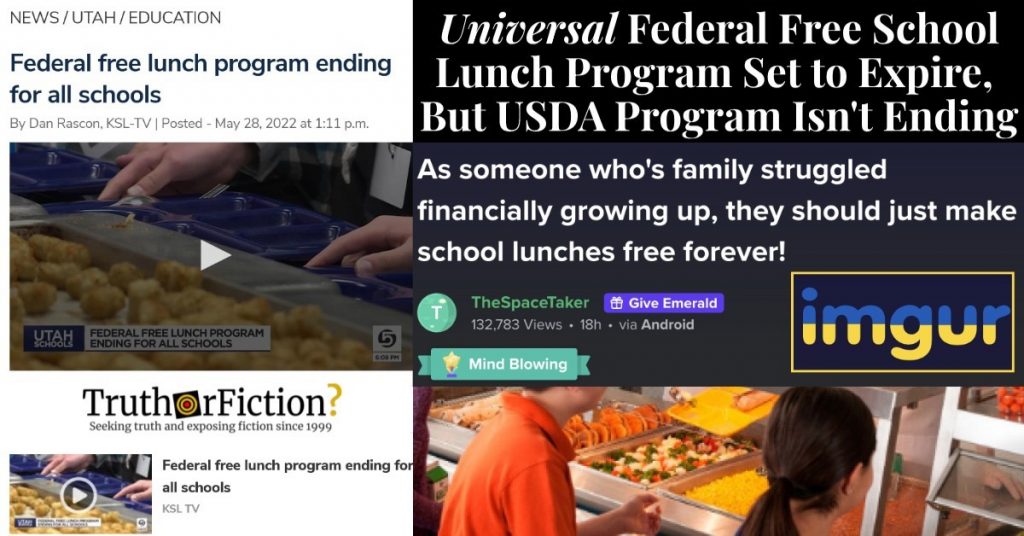On May 31 2022, a popular Imgur post indicated federal free lunches in schools was slated to end the next month:
That image-based post showed a screengrab of a May 28 2022 KSL-TV article and the headline, “Federal free lunch program ending for all schools.” In the comment section, the most upvoted replies indicated that readers were interpreting the headline as reporting that schools would no longer provide free lunch to any students:
Fact Check
Claim: A federal free lunch program in American schools will end in June 2022.
Description: There’s a claim that a federal free lunch program in American schools will end in June 2022, concerning many as it might indicate that schools would no longer provide free lunch to any students
“So many food insecure households rely on this program to ensure enough food for their kids during the week. This is a bad decision.”
“You are required to give us your kids under punishment of prison, but we aren’t going to feed them.”
“If the USA is the ‘richest country in the world,’ why can’t it feed it’s children?”
“No it’s ok, the GOP is going to replace it with the free bullets program”
“And the irony to all this is the government is continuing to collect taxes from all those parents while cutting these benefits.”
“Malnutrition during developmental years leads to a cascade of mental and physical health issues later in life; this a is cold-blooded way ..”
Presumably, commenters were referencing the United States Department of Agriculture (USDA) free lunch program, the National School Lunch Program, or NSLP. The USDA’s NSLP page defined that initiative, explaining that it was established in 1946:
The National School Lunch Program (NSLP) is a federally assisted meal program operating in public and nonprofit private schools and residential child care institutions. It provides nutritionally balanced, low-cost or free lunches to children each school day. The program was established under the National School Lunch Act, signed by President Harry Truman in 1946.
A link to a NSLP fact sheet [PDF] further explained that the NSLP was provided for eligible children, not all children, and linked to eligibility guidelines:
Children may be determined “categorically eligible” for free meals through participation in certain Federal Assistance Programs, such as the Supplemental Nutrition Assistance Program, or based on their status as a homeless, migrant, runaway, or foster child.
Children enrolled in a federally-funded Head Start Program, or a comparable State-funded pre-kindergarten program, are also categorically eligible for free meals.
Children can also qualify for free or reduced price school meals based on household income and family size. Children from families with incomes at or below 130 percent of the Federal poverty level are eligible for free meals. Those with incomes between 130 and 185 percent of the Federal poverty level are eligible for reduced price meals. Schools may not charge children more than 40 cents for a reduced price lunch
Two screenshots of the KSL-TV article were also included with the post. In that regionally specific reporting, the story noted that the policy change involved a universal program for all American schoolchildren:
Parents, listen up — no more free breakfasts or lunches for your kids. That’s because the federal government is ending its free breakfast and lunch program it started two years ago during the pandemic.
It will not go into effect until next school year [2022-2023], but officials with the Jordan School District are wanting parents to be thinking about it right now.
The day KSL visited Heartland Elementary School in West Jordan, the lunch meal choices included spaghetti and meat sauce, chicken bites and tater tots, homemade bread sticks and brownies, and a variety of fruit and salad.
The cost of all this was completely free for every single student that went through the line.
That’s the way it’s been for the last two years across the country. Students K-12 have not had to pay a penny for lunch or breakfast meals, which has been a huge financial burden lifted off of parents shoulders.
There was some news and discussion about the expiration of a universal free lunch program in late March 2022. A thread was published to Reddit’s r/AskTrumpSupporters, and another appeared on r/Teachers:
The Conversation published an explainer about the matter on March 14 2022. It summarized the issue, noting that funding for the universal program covering all students would expire on June 30 2022:
Public schools have been serving all students free meals since the COVID-19 pandemic first disrupted K-12 education. In March 2022, Congress rejected calls to keep up the federal funding required to sustain that practice and left that money out of a US$1.5 trillion spending package that President Joe Biden signed into law on March 11, 2022 … This means that next fall [in 2022], most schools will have to resume the old three-tiered system where some families don’t pay at all, some receive discounted lunches, and others must pay full price.
A popular May 31 2022 Imgur post suggested a federal free lunch program in the United States was set to expire. An article presented in screenshots discussed a Covid-era blanket policy providing all American schoolchildren with free school meals, not the broader and decades-old National School Lunch Program (NSLP). In March 2022, Congress excluded the program from a spending bill signed into law by U.S. President Joe Biden that month. Eligibility-based free lunches would likely resume for the 2022-2023 school year.
- School free lunch ending | Imgur
- National School Lunch Program
- National School Lunch Program Fact Sheet
- Federal free lunch program ending for all schools
- What do you think about universal free school meals ending? | Reddit
- End of Universal Free Lunch | Reddit
- Schools will stop serving free lunch to all students – a pandemic solution left out of a new federal spending package

